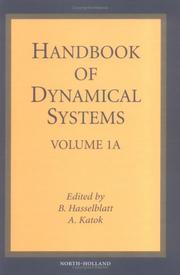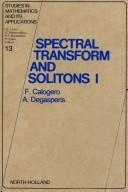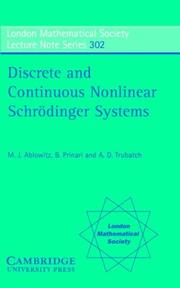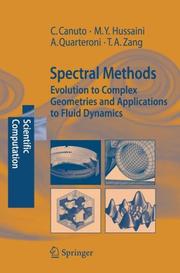| Listing 1 - 8 of 8 |
Sort by
|

ISBN: 1281956139 9786611956134 9812796746 9789812796745 9781281956132 9789812383464 9812383468 981238345X 9789812383457 9789812383457 9812383468 981238345X 6611956131 Year: 2003 Publisher: River Edge, N.J. World Scientific
Abstract | Keywords | Export | Availability | Bookmark
 Loading...
Loading...Choose an application
- Reference Manager
- EndNote
- RefWorks (Direct export to RefWorks)
A study of modern many-particle physics. It describes homogenous systems, such as electron gas in different dimensions, the quantum well in an intense magnetic field, liquid helium and nuclear matter, and addresses finite systems, such as metallic clusters, quantum dots, helium drops and nuclei.
Many-body problem --- Solid state physics. --- Physics --- Solids --- Approximation theory --- Approximation methods. --- Quantum mechanics. Quantumfield theory --- Elementary particles --- Nanostructures. --- Particles (Nuclear physics). --- Quantum theory.

ISBN: 0444853049 9780444853042 9780080871479 008087147X 1281797057 9786611797058 Year: 1979 Volume: 36 Publisher: Amsterdam ; New York : New York : North-Holland Pub. Co. ; sole distributors for the U.S.A. and Canada, Elsevier North-Holland,
Abstract | Keywords | Export | Availability | Bookmark
 Loading...
Loading...Choose an application
- Reference Manager
- EndNote
- RefWorks (Direct export to RefWorks)
Bifurcation of maps and applications
Differential geometry. Global analysis --- Nonlinear operators. --- Mappings (Mathematics) --- Bifurcation theory. --- Mappings (Mathematics). --- Nonlinear operators --- Bifurcation theory --- 517.988 --- 517.988 Nonlinear functional analysis and approximation methods --- Nonlinear functional analysis and approximation methods --- Differential equations, Nonlinear --- Stability --- Operators, Nonlinear --- Operator theory --- Maps (Mathematics) --- Functions --- Functions, Continuous --- Topology --- Transformations (Mathematics) --- Numerical solutions

ISBN: 1282878646 9786612878640 0080932266 0444531416 9780080932262 0080533442 9780080533445 1281034290 9781281034298 9780444826695 0444826696 9780444520555 0444520554 9780444501684 0444501681 9780444531414 9780444638212 0444638210 9786611034290 9786611038694 1281038695 0080532845 Year: 2002 Publisher: Amsterdam ; New York : North Holland : Elsevier,
Abstract | Keywords | Export | Availability | Bookmark
 Loading...
Loading...Choose an application
- Reference Manager
- EndNote
- RefWorks (Direct export to RefWorks)
Volumes 1A and 1B. These volumes give a comprehensive survey of dynamics written by specialists in the various subfields of dynamical systems. The presentation attains coherence through a major introductory survey by the editors that organizes the entire subject, and by ample cross-references between individual surveys. The volumes are a valuable resource for dynamicists seeking to acquaint themselves with other specialties in the field, and to mathematicians active in other branches of mathematics who wish to learn about contemporary ideas and results dynamics. Assuming only g
Differentiable dynamical systems. --- Differential dynamical systems --- Dynamical systems, Differentiable --- Dynamics, Differentiable --- Differential equations --- Global analysis (Mathematics) --- Topological dynamics --- 531.3 --- 531.3 Dynamics. Kinetics --- Dynamics. Kinetics --- Differentiable dynamical systems --- 517.988 --- 517.988 Nonlinear functional analysis and approximation methods --- Nonlinear functional analysis and approximation methods --- Bifurcation theory. --- Geometry --- Mathematics --- Physical Sciences & Mathematics

ISBN: 0444863680 9780444863683 9786611797461 1281797464 0080875343 Year: 1982 Volume: v. 13 Publisher: Amsterdam New York New York North-Holland Sole distributors for the U.S.A. and Canada, Elsevier Science Pub. Co.
Abstract | Keywords | Export | Availability | Bookmark
 Loading...
Loading...Choose an application
- Reference Manager
- EndNote
- RefWorks (Direct export to RefWorks)
Spectral Transform and Solitons
Partial differential equations --- Mathematical physics --- Evolution equations, Nonlinear. --- Solitons. --- Spectral theory (Mathematics). --- Transformations (Mathematics). --- Spectral theory (Mathematics) --- Transformations (Mathematics) --- Evolution equations, Nonlinear --- Solitons --- 517.988 --- 517.988 Nonlinear functional analysis and approximation methods --- Nonlinear functional analysis and approximation methods --- Algorithms --- Differential invariants --- Geometry, Differential --- Functional analysis --- Hilbert space --- Measure theory --- Pulses, Solitary wave --- Solitary wave pulses --- Wave pulses, Solitary --- Connections (Mathematics) --- Nonlinear theories --- Wave-motion, Theory of --- Nonlinear equations of evolution --- Nonlinear evolution equations --- Differential equations, Nonlinear

ISBN: 9780511546709 9780521534376 0511065574 9780511065576 051154670X 9780511067709 0511067704 0521534372 110712686X 1280414731 9786610414734 0511205449 0511169507 0511308353 Year: 2004 Publisher: Cambridge, UK New York Cambridge University Press
Abstract | Keywords | Export | Availability | Bookmark
 Loading...
Loading...Choose an application
- Reference Manager
- EndNote
- RefWorks (Direct export to RefWorks)
In recent years there have been important and far reaching developments in the study of nonlinear waves and a class of nonlinear wave equations which arise frequently in applications. The wide interest in this field comes from the understanding of special waves called 'solitons' and the associated development of a method of solution to a class of nonlinear wave equations termed the inverse scattering transform (IST). Before these developments, very little was known about the solutions to such 'soliton equations'. The IST technique applies to both continuous and discrete nonlinear Schrödinger equations of scalar and vector type. Also included is the IST for the Toda lattice and nonlinear ladder network, which are well-known discrete systems. This book, first published in 2003, presents the detailed mathematical analysis of the scattering theory; soliton solutions are obtained and soliton interactions, both scalar and vector, are analyzed. Much of the material is not available in the previously-published literature.
Inverse scattering transform --- Nonlinear theories --- Schrödinger equation --- 517.988 --- Equation, Schrödinger --- Schrödinger wave equation --- Differential equations, Partial --- Particles (Nuclear physics) --- Wave mechanics --- WKB approximation --- 517.988 Nonlinear functional analysis and approximation methods --- Nonlinear functional analysis and approximation methods --- Nonlinear problems --- Nonlinearity (Mathematics) --- Calculus --- Mathematical analysis --- Mathematical physics --- Scattering transform, Inverse --- Transform, Inverse scattering --- Scattering (Mathematics) --- Transformations (Mathematics) --- Schrödinger equation. --- Nonlinear theories. --- Inverse scattering transform. --- Schrodinger equation.

ISBN: 9780444852649 0444852646 9780080871462 0080871461 1281797049 9781281797049 9786611797041 6611797041 Year: 1979 Volume: 35 66 Publisher: Amsterdam New York New York North-Holland Pub. Co. Sole distributors for the U.S.A. and Canada, Elsevier North-Holland
Abstract | Keywords | Export | Availability | Bookmark
 Loading...
Loading...Choose an application
- Reference Manager
- EndNote
- RefWorks (Direct export to RefWorks)
Approximation theory and functional analysis
Functionaalanalyse. --- Functional analysis --- Approximation theory --- Analyse fonctionnelle --- Théorie de l'approximation --- Congresses. --- Congrès --- 51 --- -Functional analysis --- -517.988 --- 519.6 --- 681.3*G12 --- Functional calculus --- Calculus of variations --- Functional equations --- Integral equations --- Theory of approximation --- Functions --- Polynomials --- Chebyshev systems --- Mathematics --- Congresses --- Nonlinear functional analysis and approximation methods --- Computational mathematics. Numerical analysis. Computer programming --- Approximation: chebyshev; elementary function; least squares; linear approximation; minimax approximation and algorithms; nonlinear and rational approximation; spline and piecewise polynomial approximation (Numerical analysis) --- 681.3*G12 Approximation: chebyshev; elementary function; least squares; linear approximation; minimax approximation and algorithms; nonlinear and rational approximation; spline and piecewise polynomial approximation (Numerical analysis) --- 519.6 Computational mathematics. Numerical analysis. Computer programming --- 517.988 Nonlinear functional analysis and approximation methods --- 51 Mathematics --- 517.988 --- 51 Wiskunde. Mathematiek --- Wiskunde. Mathematiek --- Functional analysis - Congresses --- Approximation theory - Congresses

ISBN: 1280944366 9786610944361 3540307281 3540307273 3642433952 Year: 2007 Publisher: Berlin ; New York : Springer,
Abstract | Keywords | Export | Availability | Bookmark
 Loading...
Loading...Choose an application
- Reference Manager
- EndNote
- RefWorks (Direct export to RefWorks)
Spectral methods, particularly in their multidomain version, have become firmly established as a mainstream tool for scientific and engineering computation. While retaining the tight integration between the theoretical and practical aspects of spectral methods that was the hallmark of their 1988 book, Canuto et al. now incorporate the many improvements in the algorithms and the theory of spectral methods that have been made since then. This second new treatment, Evolution to Complex Geometries and Applications to Fluid Dynamics, provides an extensive overview of the essential algorithmic and theoretical aspects of spectral methods for complex geometries, in addition to detailed discussions of spectral algorithms for fluid dynamics in simple and complex geometries. Modern strategies for constructing spectral approximations in complex domains, such as spectral elements, mortar elements, and discontinuous Galerkin methods, as well as patching collocation, are introduced, analyzed, and demonstrated by means of numerous numerical examples. Representative simulations from continuum mechanics are also shown. Efficient domain decomposition preconditioners (of both Schwarz and Schur type) that are amenable to parallel implementation are surveyed. The discussion of spectral algorithms for fluid dynamics in single domains focuses on proven algorithms for the boundary-layer equations, linear and nonlinear stability analyses, incompressible Navier-Stokes problems, and both inviscid and viscous compressible flows. An overview of the modern approach to computing incompressible flows in general geometries using high-order, spectral discretizations is also provided. The recent companion book Fundamentals in Single Domains discusses the fundamentals of the approximation of solutions to ordinary and partial differential equations on single domains by expansions in smooth, global basis functions. The essential concepts and formulas from this book are included in the current text for the reader’s convenience.
Spectral theory (Mathematics) --- Numerical analysis. --- Fluid dynamics --- Approximation methods. --- Approximation theory --- Mathematical analysis --- Functional analysis --- Hilbert space --- Measure theory --- Transformations (Mathematics) --- Functional analysis. --- Computer science --- Hydraulic engineering. --- Mathematical physics. --- Functional Analysis. --- Computational Mathematics and Numerical Analysis. --- Numerical and Computational Physics, Simulation. --- Fluid- and Aerodynamics. --- Engineering Fluid Dynamics. --- Mathematical Methods in Physics. --- Mathematics. --- Physical mathematics --- Physics --- Engineering, Hydraulic --- Engineering --- Fluid mechanics --- Hydraulics --- Shore protection --- Computer mathematics --- Discrete mathematics --- Electronic data processing --- Functional calculus --- Calculus of variations --- Functional equations --- Integral equations --- Mathematics --- Computer mathematics. --- Physics. --- Fluids. --- Fluid mechanics. --- Hydromechanics --- Continuum mechanics --- Mechanics --- Hydrostatics --- Permeability --- Natural philosophy --- Philosophy, Natural --- Physical sciences --- Dynamics
Book
ISBN: 3039287990 3039287982 Year: 2020 Publisher: MDPI - Multidisciplinary Digital Publishing Institute
Abstract | Keywords | Export | Availability | Bookmark
 Loading...
Loading...Choose an application
- Reference Manager
- EndNote
- RefWorks (Direct export to RefWorks)
Graph theory is an important area of applied mathematics with a broad spectrum of applications in many fields. This book results from aSpecialIssue in the journal Mathematics entitled “Graph-Theoretic Problems and Their New Applications”. It contains 20 articles covering a broad spectrum of graph-theoretic works that were selected from 151 submitted papers after a thorough refereeing process. Among others, it includes a deep survey on mixed graphs and their use for solutions ti scheduling problems. Other subjects include topological indices, domination numbers of graphs, domination games, contraction mappings, and neutrosophic graphs. Several applications of graph theory are discussed, e.g., the use of graph theory in the context of molecular processes.
Zagreb indices --- n/a --- generating function --- mitotic cell cycle --- Mycielskian graph --- evolution theory --- grids --- “partitions” of wheel graph --- generalized hypertree --- connectivity --- single-valued neutrosophic graph --- degree of a vertex --- domination game --- interval-valued intuitionistic fuzzy graph --- directed cycle --- makespan criterion --- total-colored graph --- bipartite matching extendable graph --- stochastic convergence --- bipartite neutrosophic graph --- signless Laplacian --- complete neutrosophic graph --- k-trees --- enhanced hypercube --- b-metric space --- resistance distance --- Wiener index --- mixed graph --- line graph --- NP-hard --- generalized first Zagreb index --- inverse degree index --- sum lordeg index --- Edge Wiener --- chromatic polynomial --- degree of vertex --- complement neutrosophic graph --- graphic contraction mappings --- embedding --- Cartesian product --- k-rainbow domination number --- distance between two vertices --- evolution algebra --- k-rainbow dominating function --- PI index --- subtree --- component --- competition-independence game --- interval-valued fuzzy graph --- b-metric-like space --- induced matching extendable --- edge coloring --- degree of edge --- approximation methods --- chromatic index --- join of graphs --- genetic algorithm --- hypergraph --- edge congestion --- complement --- polynomials in graphs --- vertex coloring --- interval-valued neutrosophic graph --- spanning tree --- Kempe chain --- general contractive mappings --- DD index --- wireless multihop network and social network --- distance --- evolutionary approach --- complexity analysis --- neutrosophic graph --- Kempe-locking --- wheel graph --- Birkhoff diamond --- domination number --- k-extendable --- degree-Kirchhoff index --- adjacent matrix --- perfect matching --- spectral radius --- normalized Laplacian --- corona product --- road transport network --- extremal values --- bound --- chromatic number --- graph coloring --- combinatorial optimization --- reformulated Zagreb indices --- wirelength --- intuitionistic fuzzy graph --- unit-time scheduling --- fan graph --- "partitions" of wheel graph
| Listing 1 - 8 of 8 |
Sort by
|

 Search
Search Feedback
Feedback About UniCat
About UniCat  Help
Help News
News